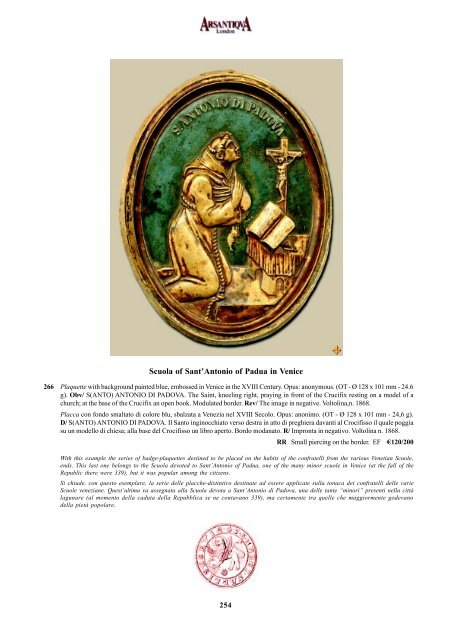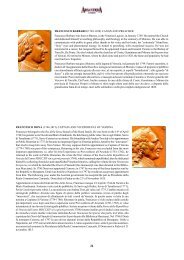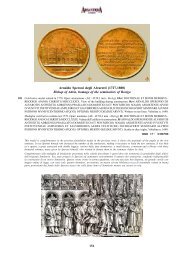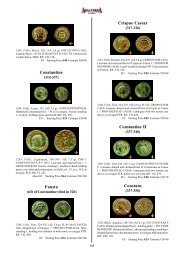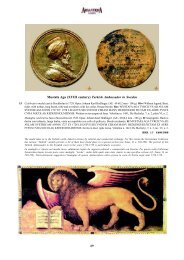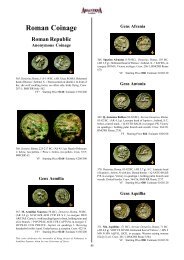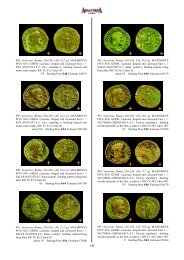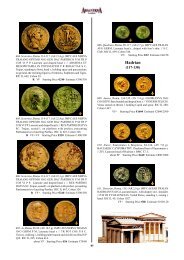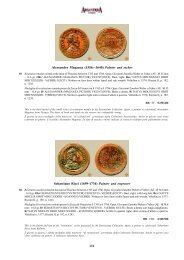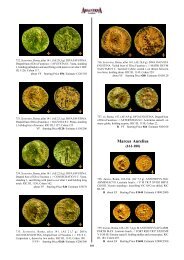Medaglie - Arsantiqva
Medaglie - Arsantiqva
Medaglie - Arsantiqva
You also want an ePaper? Increase the reach of your titles
YUMPU automatically turns print PDFs into web optimized ePapers that Google loves.
Scuola of Sant’Antonio of Padua in Venice<br />
266 Plaquette with background painted blue, embossed in Venice in the XVIII Century. Opus: anonymous. (OT - Ø 128 x 101 mm - 24.6<br />
g). Obv/ S(ANTO) ANTONIO DI PADOVA. The Saint, kneeling right, praying in front of the Crucifix resting on a model of a<br />
church; at the base of the Crucifix an open book. Modulated border. Rev/ The image in negative. Voltolina,n. 1868.<br />
Placca con fondo smaltato di colore blu, sbalzata a Venezia nel XVIII Secolo. Opus: anonimo. (OT - Ø 128 x 101 mm - 24,6 g).<br />
D/ S(ANTO) ANTONIO DI PADOVA. Il Santo inginocchiato verso destra in atto di preghiera davanti al Crocifisso il quale poggia<br />
su un modello di chiesa; alla base del Crocifisso un libro aperto. Bordo modanato. R/ Impronta in negativo. Voltolina n. 1868.<br />
RR Small piercing on the border. EF e120/200<br />
With this example the series of badge-plaquettes destined to be placed on the habits of the confratelli from the various Venetian Scuole,<br />
ends. This last one belongs to the Scuola devoted to Sant’Antonio of Padua, one of the many minor scuole in Venice (at the fall of the<br />
Republic there were 339), but it was popular among the citizens.<br />
Si chiude, con questo esemplare, la serie delle placche-distintivo destinate ad essere applicate sulla tonaca dei confratelli delle varie<br />
Scuole veneziane. Quest’ultima va assegnata alla Scuola devota a Sant’Antonio di Padova, una delle tante “minori” presenti nella città<br />
lagunare (al momento della caduta della Repubblica se ne contavano 339), ma certamente tra quelle che maggiormente godevano<br />
della pietà popolare.<br />
254
Scuola of the Devote alla Beata Vergine Maria in the Church of San Pantalon in Venice<br />
267 Celebrative medal with ornate loop, cast at Venice in the XVIII Century. Opus: anonymous. (Gilded AE-Ø26,7x25mm-6.1g).<br />
Obv/ B(EATAE) V(IRGINI) M(ARIA) SCOL(A) PIAR(VM) S(ANCTI) PANT(ALEONI). The Blessed Virgin with Child in Her<br />
arms, both crowned. Border formed by a string motif. Rev/ Without inscription. An ornament made by stylised palm leaves set in<br />
a rayed pattern. Border formed by a string motif. Voltolina n. 1869.<br />
Medaglia celebrativa con appiccagnolo ornato, fusa a Venezia nel XVIII Secolo. Opus: anonimo. (AE dorato-Ø26,7x25mm-6,1<br />
g). D/ B(EATAE) V(IRGINI) M(ARIA) SCOL(A) PIAR(VM) S(ANCTI) PANT(ALEONI). La Beata Vergine con il Bambin Gesù<br />
in braccio, entrambi incoronati. Bordo costituito da un cordoncino di filo. R/ Anepigrafo. Motivo ornamentale inciso costituito da una<br />
raggera di rami di palma stilizzati. Bordo come al dritto. Voltolina n. 1869.<br />
RRR VF+ e150/200<br />
Among the numerous Scuole and Congregations that were headquartered in the church of San Pantalon during the centuries (the more<br />
famous ones were those of the Santissimo Sacramento, Laneri, and a congregation of Dames devoted to Sant’Anna) there were two<br />
devoted to the cult of the Madonna; the one of this medal could be that of the Scuola della Visitazione.<br />
Tra le numerose Scuole e Congregazioni ospitate nel corso dei secoli dalla Chiesa di San Pantalon (più famose quella del Santissimo<br />
Sacramento, dei Laneri, e una Congregazione di Dame devote a Sant’Anna) ve ne erano due devote al culto della Madonna; quella<br />
legata alla medaglia potrebbe essere la Scuola della Visitazione.<br />
Teriaca seal lid of the spice shop “Al Redentore”<br />
268 Sealing cap cast at Venice. Opus: anonymous. (Gilded PB - Ø 41.7 mm - 24.9 g). Obv/ THERIACA FINAAL REDENTOR(E) IN<br />
VENEZIA. The haloed Christ, standing, with His right hand blesses and with His left He holds a standard. Border formed by four<br />
arches of flowers and a frieze at the four corners. Rev/ Smooth. Voltolina n. 1871; Dian V, plate III, n. 10.<br />
Tappo-sigillo fuso a Venezia. Opus: anonimo. (PB dorato - Ø 41,7 mm - 24,9 g). D/ THERIACA FINA AL REDENTOR(E) IN<br />
VENEZIA. Il Redentore nimbato, stante, con la mano destra benedice, con la sinistra tiene il vessillo. Bordo formato da quattro archi,<br />
costituiti da corolle di fiori, intercalati ai quattro poli da un fregio. R/ Liscio. Voltolina n. 1871; Dian V, tav. III, n. 10.<br />
RR EF e200/300<br />
Throughout the XVIII century, the production of the “miraculous” teriaca continued to be a reason of pride for the pharmacies and<br />
“spezierie” authorised by the Venetian government. For reasons of jealousy, the pharmacists put their symbols on their “own” teriaca.<br />
The pharmacy of “Al Redentore” was near Piazza San Marco and was active until a few years ago.<br />
Per tutto il Settecento la produzione della “miracolosa” teriaca continuò a costituire motivo di orgoglio per le farmacie e “spezierie”<br />
autorizzate dal Governo veneto. Gelosi delle loro prerogative, i farmacisti apponevano sui tappi della “loro” teriaca i propri simboli. La<br />
farmacia “Al Redentore” si trovava a pochi passi da Piazza San Marco ed è rimasta attiva fino a pochi anni or sono.<br />
255
Andrea Gritti (1523-1538) LXXVII Doge and Girolamo Priuli (1559-1567) LXXXIII Doge<br />
269 Restitution medal cast at Venice in the XVIII Century. Opus: anonymous. (AE - Ø 40.7 mm - 23.6 g). Obv/ ANDREAS GRITI DVX<br />
VENETIAR(VM). Flowered cross in the field within two dotted circles. Rev/ HIER(ONYMVS) PRIOLO DVX S(ANCTVS)<br />
M(ARCVS) VENETVS. San Marco seated left and blessing, in front of him the kneeling Doge, holding a staff with cross and<br />
standard. Voltolina n. 1873.<br />
Medaglia di restituzione fusa a Venezia nel XVIII Secolo. Opus: anonimo. (AE - Ø 40,7 mm - 23,6 g). D/ ANDREAS GRITI DVX<br />
VENETIAR(VM). Croce fiorata nel campo, scritta entro due cerchi perlinati. R/ HIER(ONYMVS) PRIOLO DVX S(ANCTVS)<br />
M(ARCVS) VENETVS. San Marco benedicente seduto sulla sinistra, davanti a lui il Doge inginocchiato tiene nelle mani un’asta con<br />
croce e vessillo. Voltolina n. 1873.<br />
RRR EF e300/500<br />
This unusual and rare medal celebrates two Dogi of the XVI Century, each on one side of the medal. The iconography is based on symbols<br />
and stereotypes; only the legends help us to recognise Andrea Gritti and Girolamo Priuli.<br />
Questa insolita e rara medaglia celebra due Dogi del XVI Secolo, assegnando una faccia della medaglia a ciascuno. L’iconografia è<br />
giocata su simboli e figure stereotipati. Solo le leggende consentono di riconoscere Andrea Gritti e Girolamo Priuli.<br />
Giacomo Foscarini (XVIII century)<br />
270 Celebrative medal coined at the mint of Venice in the XVIII Century. Opus: anonymous. (AE - Ø 27.3 mm - 4.1 g). Obv/ Without<br />
inscription. Laureate bust of Giacomo Foscarini right, within a frieze. Dotted border. Rev/ GIACOMO FOSC(ARINI). Written on<br />
three lines within frieze. Dotted border. Voltolina n. 1875; Correr, Tessere, n. 188.<br />
Medaglia celebrativa coniata presso la Zecca di Venezia nel XVIII Secolo. Opus: anonimo. (AE - Ø 27,3 mm - 4,1 g). D/Anepigrafe.<br />
Busto a destra laureato di Giacomo Foscarini contornato da un fregio. Bordo perlinato. R/ GIACOMO FOSC(ARINI). Scritta in tre<br />
righe contornata da un fregio. Bordo perlinato. Voltolina n. 1875; Correr, Tessere, n. 188.<br />
RRR VF e300/500<br />
This rare medal, made in Venice during the XVIII Century, is a problem as regards identification of the person portrayed. Part of the<br />
surname on the legend could refer to three Venetian families: Foscolo, Foscari or Foscarini. On the basis of archive documents, the medal<br />
could refer to Giacomo Foscarini, but it is impossible to say which one, since between 1725 and 1765 fifteen of the same name were born<br />
in Venice.<br />
Questa rara medaglia, realizzata a Venezia nel XVIII Secolo, costituisce una specie di rompicapo per quanto riguarda l’identificazione<br />
del personaggio. In effetti la parte di cognome presente nella legenda potrebbe riferirsi a una delle 3 famiglie veneziane: Foscolo,<br />
Foscari o Foscarini. Sulla base di documenti d’archivio la medaglia va senza dubbio riferita a un Giacomo Foscarini, ma non è<br />
possibile precisare a quale, dato che, fra il 1725 e il 1765 risultano esserne nati, nella città lagunare, una quindicina.<br />
256
Academy of the Quieti<br />
271 Celebrative medal coined at the mint of Venice in the XVIII Century. Opus: anonymous. (AE -Ø31mm-8.8g).Obv/ QVIETI<br />
XXX. Written on two lines over a ten-pointed star, within a frieze. Dotted border. Rev/ QVIETI XXX. Written on two lines over<br />
a ten pointed star, within a frieze. Dotted border. Voltolina n. 1876; Correr, Tessere, n. 185.<br />
Medaglia celebrativa coniata presso la Zecca di Venezia nel XVIII Secolo. Opus: anonimo. (AE-Ø31mm-8,8g).D/ QVIETI XXX.<br />
Scritta in due righe con sopra un astro a dieci punte, contornata da un fregio. Bordo perlinato. R/ QVIETI XXX. Scritta in due righe<br />
con sopra un astro a dieci punte, contornata da un fregio. Bordo perlinato. Voltolina n. 1876; Correr, Tessere, n. 185.<br />
RRR F+ e300/500<br />
This medal, clearly made in Venice, refers to one of the many Academies that were founded in Venice and Italy between the XVII and XVIII<br />
Century. Nothing remains of this Academy. The technical characteristics do not help to date this medal more accurately than the XVIII<br />
century. But we can consider that from the 10th of September 1768, by decree of the Venetian government, the Academies of the Republic<br />
had to “transform” themselves into practical organisations that operated for the progress of the territory, in the economic and technical<br />
field (and called Academies of agriculture, commerce and arts, etc.), so that the Academy of the Quieti and its medal should go back to<br />
the middle of the XVIII century.<br />
La medaglia, di chiara matrice veneziana, è relativa a una delle numerosissime accademie che sorsero a Venezia e in Italia tra Seicento<br />
e Settecento. Di essa nulla è rimasto. Le caratteristiche tecniche non consentono una datazione più precisa del XVIII secolo. Se si<br />
considera però che dal 10 settembre 1768, per decreto del Governo Veneto, le Accademie della Repubblica dovettero “trasformarsi” in<br />
organizzazioni pratiche, operative per il progresso economico e tecnico del territorio (assumendo il nome di Accademie di agricoltura,<br />
o commercio e arti ecc.), l’Accademia dei Quieti e la relativa medaglia dovrebbero collocarsi verso la metà del Settecento.<br />
Academy of the Fantastici<br />
272 Merit medal with loop, cast at Udine in the XVIII Century. Opus: anonymous. (Gilded AE - Ø 39.6 mm - 27.55 g). Obv/ SEDEM<br />
SOMNIA TENERE FERUNT AENEI(DOS) VI. A tree full of branches. Rev/ PRAEMIUM LI(T)TERIS PHANTASTICORUM<br />
ACCADEMIA. Written on three lines; under, a six-pointed star. Voltolina n. 1878; Ostermann 1881, p. 179, n. 130.<br />
Medaglia di benemerenza con appiccagnolo, fusa a Udine nel XVIII Secolo. Opus: anonimo. (AE dorato - Ø 39,6 mm - 27,55 g).<br />
D/ SEDEM SOMNIA TENERE FERUNT AENEI(DOS) VI. Albero carico di fronde. R/ PRAEMIUM LI(T)TERIS<br />
PHANTASTICORUM ACCADEMIA. Scritta in tre righe; in basso un astro a sei punte. Voltolina n. 1878; Ostermann 1881, p. 179,<br />
n. 130.<br />
RRR EF e300/500<br />
It is a merit medal that the Academy of the Fantastici awarded to those who had obtained merit in the field of letters. The Academy was<br />
in Udine, but not much is known; during the XIX Century commentators thought that the Academy was in the “house of the Conti Gorgo,<br />
now Maniago”.<br />
Si tratta di una medaglia di benemerenza assegnata dall’Accademia dei Fantastici a coloro che avevano ben meritato nel campo delle<br />
lettere. L’Accademia, di cui si sa ben poco, ebbe sede a Udine; commentatori ottocenteschi arrivano a precisare che era ospitata “in casa<br />
dei Conti Gorgo, ora Maniago”.<br />
257
Oswald King of Northumbria (VII Century) Saint and the Sacred Family<br />
273 Devotional medal cast at Venice in the XVIII Century. Opus: anonymous. (AR - Ø oval 30.4 x 27.8<br />
mm - 7.5 g). Obv/ S(ANT’) OSVALDO R(E) D(I) NO(R)TUMBRIA. The King Saint facing, with<br />
his traditional robes, a cloak on his shoulder, crowned and haloed, holding a sceptre in his right hand<br />
and crow with a ring on the left. Rev/ S(ANCTA) CHRIST(IANA) FAM(ILIA). The Madonna with<br />
Child Jesus in Her arms, together with San Giuseppe, Sant’Anna and San Gioacchino. Voltolina<br />
n. 1883.<br />
Medaglia devozionale fusa a Venezia nel XVIII Secolo. Opus: anonimo. (AR - Ø ovale 30,4 x 27,8 mm<br />
- 7,5 g). D/ S(ANT’) OSVALDO R(E) D(I) NO(R)TUMBRIA. Il Santo Re di fronte, nel suo costume<br />
tradizionale, col mantello sulle spalle, corona in testa ed aureola, lo scettro nella destra e il corvo<br />
portante l’anello sulla sinistra. R/ S(ANCTA) CHRIST(IANA) FAM(ILIA). La Madonna con in<br />
braccio il Bambin Gesù assieme a San Giuseppe, Sant’Anna e San Gioacchino. Voltolina n. 1883.<br />
RRR EF e500/800<br />
A devotional medal is here on offer, where there is the less common figure of Saint Oswald next to the Holy<br />
Family. On the extraordinary devotion towards this Saint in the Venetian Republic, especially in Friuli, at<br />
Sauris (where there was the most celebrated sanctuary dedicated to him), see the note at lot n. 1. Even in<br />
Venice there were places with a scuola devoted to him; the most famous were the confraternite at the<br />
churches of San Stae (that on the facade has a statue of the Saint) and San Silvestro.<br />
Viene qui proposta una medaglia devozionale su cui campeggia, accanto alla Sacra Famiglia, la figura,<br />
meno comune, di Sant’Osvaldo. Sulla straordinaria devozione che veniva attribuita a questo santo nei<br />
territori della Repubblica e in particolare nel Friuli, a Sauris (dove si trovava il più celebre santuario a<br />
lui dedicato), si rinvia alla scheda n. 1. Anche a Venezia però fiorirono vari luoghi e scuole di devozione;<br />
le più famose furono le confraternite ospitate presso la Chiesa di San Stae (sulla cui facciata giganteggia<br />
ancor oggi una statua del Santo) e presso la Chiesa di San Silvestro.<br />
Scuola Grande of San Teodoro in Venice<br />
274 Celebrative medal coined at Rome in 1805. Opus: Tommaso Mercandetti. (AE-Ø41mm<br />
- 31.9 g). Obv/ S(ANCTVS) THEODORVS MAR(TYR) AMASSENVS - T(HOMAS)<br />
M(ERCANDETTI) I(NVENIT) ET S(CVLPSIT). The Saint on horseback moving right,<br />
spearing the demon shown as a dragon. Rev/ THOMAS AMBROSIONIVS CVSTOS<br />
MAGNVS MDCCCV. Written on four lines within two crossed laurel branches. Voltolina<br />
n. 1888.<br />
Medaglia celebrativa coniata a Roma nel 1805. Opus: Tommaso Mercandetti. (AE-Ø41<br />
mm - 31,9 g). D/ S(ANCTVS) THEODORVS MAR(TYR) AMASSENVS - T(HOMAS)<br />
M(ERCANDETTI) I(NVENIT) ET S(CVLPSIT). Il Santo a cavallo, andante a destra,<br />
mentre trafigge con la sua lancia il demonio rappresentato da un drago. R/ THOMAS<br />
AMBROSIONIVS CVSTOS MAGNVS MDCCCV. Scritta in quattro righe entro due rami<br />
di alloro incrociati. Voltolina n. 1888.<br />
RR FDC e400/800<br />
The Scuola of San Teodoro was founded in 1258. Saint Teodoro was, for a long time, patron<br />
of Venice. The Confraternita was soon enrolled among the Scuole Grandi and had a headquarters<br />
and prestigious furnishings. Like the other Scuole, it too had to face the decadence of the last<br />
years of the Republic and then the Napoleonic violence (with the robbery of precious objects<br />
and works of art), and finally the humiliation of the first Austrian domination (the headquarters<br />
were used as a flour deposit). But the Scuola survived and respected the tradition of the<br />
distribution of the annual medals. The protagonist of this “miracle” was the Guardian Grande<br />
in 1805, Tommaso Ambrosini. A few months later, with the return of the French, the systematic<br />
spoliation of the Scuola started, and then it was definitely suppressed by the well-known<br />
Napoleonic decree. We can affirm that this medal, made after the fall of the Republic, is the<br />
symbol of the “moral” end, the last testimony of the Venetian institutions that were the Scuole<br />
Grandi of Devotion.<br />
La Scuola di San Teodoro venne istituita nel 1258. Il Santo cui era intitolata fu a lungo<br />
patrono di Venezia. La Confraternita venne presto ascritta fra le Grandi e si munì di una sede<br />
e di arredi prestigiosi. Come le altre Scuole anch’essa dovette subire, prima la decadenza che<br />
accompagnò gli ultimi anni della Repubblica, poi la violenza napoleonica (con spoliazioni di<br />
oggetti preziosi e opere d’arte), e infine l’umiliazione della prima dominazione austriaca (la<br />
sede venne utilizzata come deposito di farine). Riuscì comunque a sopravvivere e addirittura<br />
rispettare la tradizione della distribuzione delle medaglie annuali. Protagonista di questo<br />
“miracolo” fu, nel 1805, il suo Guardian Grande Tommaso Ambrosini. Pochi mesi dopo, con<br />
il ritorno dei Francesi, aveva inizio la sistematica spoliazione della Scuola che sarebbe poi<br />
stata definitivamente soppressa dai noti decreti napoleonici. Si può dunque affermare che<br />
questa medaglia, pur realizzata dopo la caduta della Repubblica, ne simboleggia la fine, per<br />
così dire, morale, essendo l’ultima testimonianza di quell’istituto venezianissimo costituito<br />
dalle Scuole Grandi di Devozione.<br />
258
Antonio of Padua (1191-1231) Saint and the crowning of the Madonna<br />
275 Devotional medal with a loop with octagonal piercing, cast at Padua in the XVIII Century. Opus: anonymous. (AR - Ø 31.2 mm -<br />
7.2 g). Obv/ S(ANCTVS)ANTONI(VS) (D)E PAD(VA). The Saint kneeling in front of an altar, turned left. Rev/ Without inscription.<br />
The Madonna, standing facing, crowned by God on Her left, Christ at Her right, above Them, the Dove of the Holy Ghost. Voltolina<br />
n. 1880.<br />
Medaglia devozionale con appiccagnolo con foro ortogonale, fusa a Padova nel XVIII Secolo. Opus: anonimo. (AR - Ø 31,2 mm -<br />
7,2 g). D/ S(ANCTVS)ANTONI(VS) (D)E PAD(VA). Il Santo inginocchiato davanti ad un altare rivolto verso sinistra. R/ Anepigrafe.<br />
La Madonna, stante di fronte nell’atto di essere incoronata da Dio alla sua sinistra, con il Cristo alla sua destra, sopra di loro la<br />
Colomba dello Spirito Santo. Voltolina n. 1880.<br />
R F+ e120/200<br />
It is a devotional medal made in a precious metal with the figure of the Saint object of much devotion in the Veneto area: Sant’Antonio<br />
of Padua. Together with this powerful healer, there is the reassuring figure of the Madonna with the Lord.<br />
Si tratta di una medaglia devozionale eseguita in metallo prezioso, che propone la figura del Santo oggetto della massima devozione<br />
nell’area veneta: Sant’Antonio di Padova. Al potente taumaturgo è associata la rappresentazione, sempre rassicurante, della Madonna<br />
affiancata dalla Divinità.<br />
Antonio of Padua (1191-1231) Saint and the Holy House of Loreto<br />
276 Devotional medal with large, transversal loop, cast in the XVIII Century. Opus: anonymous. (AR - Ø 31.9 mm - 7.5 g).<br />
Obv/ S(ANCTVS) ANT(ONIVS) DE PAD(VA). The Saint with halo and Cappucin habit, kneeling left, praying in front of the Child<br />
Jesus, rayed head and standing bare-footed on a cloud. Rev/ SANCTA DOMVS. The Holy House of Loreto transported by two<br />
angels, over the roof, the Madonna with Child Jesus in Her arms. Voltolina n. 1881.<br />
Medaglia devozionale con appiccagnolo massiccio trasversale, fusa nel XVIII Secolo. Opus: anonimo. (AR - Ø 31,9 mm - 7,5 g).<br />
D/ S(ANCTVS) ANT(ONIVS) DE PAD(VA). Il Santo aureolato e con l’abito cappuccino, volto a sinistra in ginocchio, sta in atto di<br />
preghiera davanti al Bambino Gesù con il capo raggiante e in piedi nudo sopra una nuvoletta. R/ SANCTA DOMVS. La Santa Casa<br />
di Loreto trasportata da due angeli, sopra il tetto sta seduta la Madonna con il Bambino Gesù in braccio. Voltolina n. 1881.<br />
RR VF e200/300<br />
In this devotional medal, Saint Antonio of Padua and the Madonna are shown once more. She is next to the Church of S. Maria of Loreto<br />
which, according to an ancient tradition, was the house where the Madonna was born and where She heard the Annunciation of Her<br />
maternity and where Christ lived with His family until He was thirty. The small house was transported by angels to the hill of Tersatto, near<br />
Fiume in Dalmatia, then near Recanati, and from there to the hill of Loreto.<br />
In questa medaglia devozionale appaiono, ancora una volta associati, Sant’Antonio di Padova e la Madonna. Quest’ultima è accostata<br />
alla Chiesa di S. Maria di Loreto che, secondo un’antica tradizione, altro non sarebbe che la casa nella quale la Madonna nacque e<br />
ricevette l’annuncio della maternità e dove Gesù visse con la famiglia fino al trentesimo anno di età. La piccola abitazione fu trasportata<br />
miracolosamente dagli angeli dapprima sopra il colle di Tersatto, presso Fiume, in Dalmazia, poi nelle vicinanze di Recanati, e da lì<br />
infine sul colle di Loreto.<br />
259
Saint Antonio and the Madonna of Loreto<br />
277 Devotional medal with loop, coined in the XVIII Century. Opus: anonymous. (AE - Ø 32.3 mm -<br />
10.3 g). Obv/ S(ANTO) ANTONIO D(I) PADVA. Saint Antonio with halo, turned to look at the<br />
statue of Child Jesus on a basement; in his right hand he holds a lily. Rev/ S(ANTA) MARIA<br />
LAVRET(ANA). The Madonna of Loreto with the Child in Her arms, both crowned with rays.<br />
Medaglia devozionale con appiccagnolo, coniata nel XVIII Secolo. Opus: anonimo. (AE - Ø 32,3<br />
mm - 10,3 g). D/ S(ANTO) ANTONIO D(I) PADVA. Sant’Antonio aureolato volto a osservare la<br />
statua del Bambin Gesù su di un piedistallo; con la destra regge il giglio. R/ S(ANTA) MARIA<br />
LAVRET(ANA). La Madonna di Loreto con il Bimbo in braccio; entrambi con corona raggiante.<br />
RR VF e120/150<br />
The medal belongs to the same type as the previous one and shows the devotion that the Saint from<br />
Padua had in the Veneto area, together with the Madonna of Loreto.<br />
La medaglia appartiene alla stessa tipologia della precedente e testimonia la devozione di cui godette<br />
il Santo di Padova in area veneta in questo particolare abbinamento con la Madonna di Loreto.<br />
Scuola Grande of Santa Maria della Carità in Venice<br />
The Patriarch Guido<br />
278 Celebrative medal coined at the mint of Venice in the last quarter of the XVIII Century.<br />
Opus: Antonio Schabel. (AR - Ø 41.4 mm - 28.5 g). Obv/ BENIGNA EST OMNIA<br />
SVSTINET - A(NTONIVS) SCHABEL F(ECIT). Female figure, Charity, seated right,<br />
holding child in her left arm that she is feeding; with her right arm she hugs another; a third<br />
child, on the right, shows the symbol of the Scuola. Rev/ GVIDONI PATRIARCH(AE)<br />
GRAD(ENSI) FAVSTE FEL(ICITER) CONSOCIATO A(NNO) MCCLXXX. Coat of<br />
arms with flaming and stabbed heart, on a book, surmounted by a cardinal’s hat with the<br />
two cords, each with six knots.<br />
Medaglia celebrativa coniata presso la Zecca di Venezia nell’ultimo quarto del XVIII<br />
Secolo. Opus: Antonio Schabel. (AR - Ø 41,4 mm - 28,5 g). D/ BENIGNA EST OMNIA<br />
SVSTINET - A(NTONIVS) SCHABEL F(ECIT). Figura femminile rappresentante la<br />
Carità seduta verso destra, col braccio sinistro regge un bambino che sta allattando e col<br />
destro ne abbraccia un altro; un terzo, sulla destra, esibisce il simbolo della Scuola.<br />
R/ GVIDONI PATRIARCH(AE) GRAD(ENSI) FAVSTE FEL(ICITER) CONSOCIATO<br />
A(NNO) MCCLXXX. Stemma con cuore fiammeggiante, trafitto, posto su di un libro,<br />
sormontato da cappello cardinalizio dal quale pendono i due cordoni con sei fiocchi<br />
ciascuno.<br />
RRRR EF e1500/2000<br />
This medal belongs to the series celebrating the most significant moments of the history of<br />
the Scuola della Carità; it celebrates an illustrious and ancient confratello: friar Guido,<br />
Patriarch of Grado, who lived in the XIII Century. He belonged to the Order of the Eremitani<br />
of Sant’Agostino, and was appointed Patriarch of Grado in 1279. He lived in Venice where<br />
he held four churches in the city. He remained in the city till his death in 1288. It is evident<br />
that to have a similar member among its own confratelli was a motive of prestige for the<br />
“young” Scuola della Carità. The rarity of this medal and the fact that it is made by Schabel<br />
(see n. 108, 143, 156, 157, 168 and 228), make this example particularly sought after.<br />
Questa medaglia, appartenente alla serie che celebra i momenti più significativi della storia<br />
della Scuola della Carità, ricorda un illustre e antico confratello: frate Guido, patriarca di<br />
Grado, vissuto nel XIII Secolo. Appartenente all’Ordine degli Eremitani di Sant’Agostino,<br />
egli fu nominato patriarca di Grado nel 1279. Di fatto però egli risiedeva a Venezia dove<br />
reggeva direttamente quattro chiese della città. Qui egli rimase sino alla morte, avvenuta<br />
nel 1288. É evidente che poter ascrivere tra i propri confratelli un simile personaggio, aveva<br />
costituito per la “giovane” Scuola della Carità motivo di notevole prestigio. La rarità di<br />
questa medaglia e il fatto che appartenga alla serie realizzata dallo Schabel (cfr. nn. 108,<br />
143, 156, 157, 168 e 228), rendono questo esemplare particolarmente ambito.<br />
260
Printed by<br />
Reggiani S.p.A - Varese<br />
Tel. +39 0332 338111


